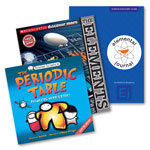The Elemental Journal is the backbone for a delightful unit study approach for learning about the elements of the periodic table. This study might be used with students in about grades 5 through 12. The course uses the Elemental Journal in conjunction with two resource books, The Periodic Table: Elements with Style! and The Elements: The Building Blocks of the Universe.
Both of these resource books are full-color, heavily illustrated books that are very visually appealing. In addition, students will watch an online video along with each lesson. Videos, created by scientists at the University of Nottingham, demonstrate experiments with the elements to help illustrate their properties. Videos seem to run anywhere from about one to nine minutes in length.
Students will read, research, and watch videos, then draw and write about what they have learned or observed. The writing component of this course requires students to frequently summarize what they have learned in full paragraphs.
The first lesson “Preliminary Research” introducing students to elements, atoms, and the periodic table. Through the rest of this course, students research and write about 42 of the 144 known elements, learning about relationships between various groups within the periodic table.
The course should take about 30 hours to complete. While the authors suggest an hour per week over the course of a school year, you can do more frequent lessons to complete the course in less time if you wish.
The Elemental Journal is both workbook and guide. Everything is laid out so that it is very easy to work through each lesson, and students will write directly in their books. For example, the lesson on “Group 15: Nitrogen Elements,” begins with reading assignments in the two books. In The Periodic Table, a two-page spread introduces this group of six elements with brief information. The Elements has brief text and information on Nitrogen that they should read next. Students will write a paragraph summarizing what they have learned.
The next page in the Elemental Journal focuses on nitrogen alone, and two additional pages let students select two of the Group 15 elements to study. For each element, they will complete a number of activities. They will fill in a box with the element’s name, symbol, atomic number, and atomic weight. Another box is provided for students to draw the symbol. No specific instructions for the drawing are included, but pictures of elements are available in The Elements on pages 24-25. These pages use the colored glow to illustrate gases—a glow produced when electricity passes through them. Students could use similar “color” illustration for an element or they might be inspired with another idea from illustrations of the element—e.g., The Hindenburg for hydrogen or a neon sign for neon. Below the boxes students fill in blanks with the classification, standard state, color, date discovered, and character traits. Next they write in response to, “What three interesting facts did you discover?” After that, they should watch the video about the element then write a paragraph summarizing the highlights of the video.
Some side notes on the videos: Even though the videos are not professionally produced, they are often very entertaining and impressive. However, I wouldn’t expect students who haven’t already studied chemistry to fully understand them. Students might find the scientific explanations beyond their comprehension, so they might focus on visual effects rather than the science for their summaries. If students find the videos too far beyond their comprehension level, you might skip the videos and the corresponding writing assignments. Also note that the URL for the site for the videos is at the front of the book, and this is not repeated in the lessons. You will go to the site and simply click on the element studied in that lesson to watch the pertinent video.
Students will not read through the entirety of the resource books if they follow only the assigned readings, but I expect that most students will want to browse through The Elements on their own since it is such a gorgeous and interesting book.
The publisher does not specify recommended grade levels for this course. I think that some children as young as fifth grade will find it fascinating, and they will be able to do an adequate job with the written work. However, I think grades six through eight are the ideal time to use it, both because of their skill level and because the course should serve as an interesting vehicle for building a foundation for further study in chemistry in high school.









